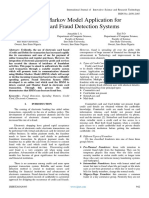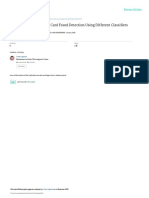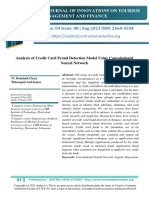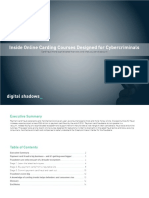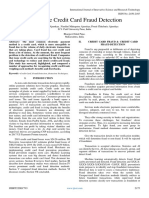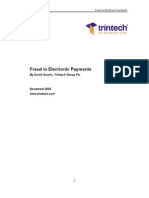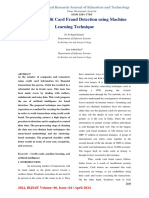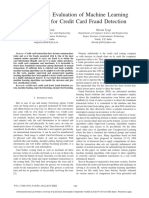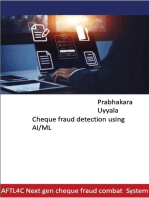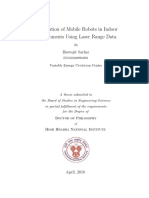Professional Documents
Culture Documents
Credit Card Fraud Detection System
Credit Card Fraud Detection System
Copyright
Available Formats
Share this document
Did you find this document useful?
Is this content inappropriate?
Report this DocumentCopyright:
Available Formats
Credit Card Fraud Detection System
Credit Card Fraud Detection System
Copyright:
Available Formats
Volume 9, Issue 4, April – 2024 International Journal of Innovative Science and Research Technology
ISSN No:-2456-2165 https://doi.org/10.38124/ijisrt/IJISRT24APR939
Credit Card Fraud Detection System
Dhanashree Diwase1; Janhavi Warkari2; Abhishek Gawali3; Swati Shamkuwar 4
1,2,3,4
Department of Information Technology, G.H. Raisoni College of Engineering, Nagpur, India,
Abstract:- Globally, credit card fraud is a serious threat constantly must fight to keep ahead of scammers and
to people, businesses, and financial institutions. With the safeguard the integrity of the payment system.
rise of online transactions, fraudsters have developed
clever ways to take advantage of loopholes in payment The impact of credit card fraud is extensive and affects
systems. Traditional fraud detection methods based on a wide range of people. The impact on financial institutions
manual inspections and rules-based systems are unable goes beyond lost revenue; They also face regulatory scrutiny
to counteract this new and evolving risk. As a result, the and loss of their brand. Financing could be severely strained
use of data analytics and machine learning has become a by the cost of reimbursing cardholders for fraudulent
viable option for real-time detection and prevention of purchases, monitoring incidents, and putting fraud
credit card fraud. The paper looks at using machine protection measures in place Again also, financial
learning algorithms such as logistic regression, decision institutions risk fines and legal action if they fail to
trees, random forests, neural networks, etc. to detect adequately protect customer data and stop fraud. Credit card
fraudulent transactions We go over the importance of fraud disproportionately affects merchants, costing them
data sources and components, analytical metrics, and money in lost sales, penalty charges, and damaged consumer
how fraud detection on the effectiveness of examples. In trust. Small businesses in particular may find it difficult to
addition, we list the current challenges and directions in recover from the loss of revenue caused by fraudulent
which credit card fraud detection is likely to continue, transactions, jeopardizing their sustainability and future
including the use of blockchain technology and growth opportunities. [1,2]
sophisticated AI techniques. Overall, this study
highlights the importance of credit card theft detection Also, merchants bear a disproportionate share of the
and the promise of machine learning in mitigating this cost of fraud prevention solutions such as PCI DSS
ubiquitous problem financial institutions use advanced compliance, EMV chip technology, which increases
machine learning algorithms and analytics function to operational costs. Theft undermines consumer confidence in
detect fraudulent behaviour, protect customer interests, the security of electronic payments in , resulting in fewer
and maintain payment environment integrity to improve people using their cards, more people switching to
their capabilities. alternative payment methods In this context, protecting the
interests of all parties involved and maintaining trust a
Keywords:- Credit Card Fraud Detection, Machine maintained in the integrity of the payments ecosystem
Learning, Deep Learning, Anomaly Detection, Performance depends largely on effective fraud detection and prevention
Metrics. strategies.
I. INTRODUCTION II. METHODS OF CREDIT CARD FRAUD
DETECTION
Credit cards provide consumers and businesses with
unmatched ease and flexibility in today's interconnected Card Skimming
digital economy, helping to facilitate a wide range of The most common type of credit card fraud is called
transactions. But in addition to the advantages of using "card skimming," which consists of card skimming devices
credit cards, there is a constant and widespread risk in the that are smuggled into popular card readers such as ATMs or
shape of credit card theft. Financial institutions, retailers, point-of-sale terminals when a card is inserted for a
and cardholders throughout the world face serious transaction Name, account number, expiration date, and
difficulties because of this danger, which includes a variety other sensitive information needed to secure the transaction
of illegal activities such as identity theft, unauthorized are often included in the stolen data.[3] Fraudsters can then
transactions, and account takeover. Technology use this information to create fake cards or run illegal
advancements and the growing popularity of online transactions, costing cardholders and financial institutions a
shopping have made credit card fraud even more complex lot of money scraping machines can be hard to detect
by giving thieves access to more advanced methods for because they can be incredibly tricky, blended seamlessly
targeting weaknesses in the payment system. with the original card reader.
These tactics consist of, but are not restricted to, point- To further support the fraudulent activity, attackers can
of-sale terminal card skimming devices, scams attack at also use other techniques such as overlays or hidden
gullible customers, and advanced malware intended to steal cameras to record PINs. Dealers and consumers need to be
cardholder information. Because of this, the financial sector extra careful about finding spinning machines. This requires
IJISRT24APR939 www.ijisrt.com 861
Volume 9, Issue 4, April – 2024 International Journal of Innovative Science and Research Technology
ISSN No:-2456-2165 https://doi.org/10.38124/ijisrt/IJISRT24APR939
careful monitoring of card readers for any discrepancies or bank, this includes using stolen credit card credentials for
signs of tampering. Advanced security measures can help small transactions or lit purchases considered.
prevent card hacking attempts and protect cardholder
information. These include non-destructive seals, periodic If the stolen credit card information passes half the test,
maintenance, and storage technologies. However, skimming fraudsters use the compromised credit card information to
techniques highlight how difficult it will always be to deal create a fake credit card. Stolen card information using
with this type of credit card fraud. [2,3] magnetic tape writers or other card copying devices is often
applied to blank or counterfeit cards throughout this process
Phishing after which the counterfeit card imitates the cardholder real
Phishing is a type of cybercrime that involves information and ready to be used for illegal transactions or
fraudulent attempts to obtain personal information from withdrawal of funds.
people such as credit card numbers, usernames, passwords,
etc. Usually heard through electronic messaging systems Fraudsters use a variety of techniques to commit illegal
that instant messaging, SMS, and email use such efforts. acts through fake documents, such as purchases in physical
Phishing is the practice of impersonating reputable locations, use of online trading platforms, advance
companies or organizations—such as banks, social media withdrawals at ATMs or reducing the privilege of banking
platforms, Internet retailers, or government agencies—that a types or merchants will find it. Money laundering
victim can trust social engineering techniques are often used techniques are another tactic used by fraudsters from time to
use phishing attacks to lure victims into revealing private time. The proceeds of fraudulent transactions are used to
information or taking actions that threaten their security. launder money through various channels such as
cryptocurrency exchanges, offshore bank accounts and shell
Sometimes, Phishing emails or messages contain corporations.
creative or interesting requests, such as reporting an account
security breach, requests to verify account information, offer Card Not Present (CNP)
incentives or rewards These messages can created links to a Card Not Present (CNP) fraud is a common form of
fake website that appears a lot. Sometimes the letters contain credit card fraud when a physical credit card is not presented
viruses or malicious software that, if detected, can infect the during online or telephone transactions. Cybercriminals use
victim's computer with malware and infect the attacker gain a variety of methods to obtain credit card information, such
access to the victim’s device, allowing it to retrieve as data breaches, phishing schemes, or purchasing stolen
confidential data or access systems without confidentiality. card numbers from shady Internet marketplaces called
"carding platforms" Once this data is obtained a, this data is
Phishing Attacks can Take Various Forms, Including: used—without the cardholder’s knowledge—for illegal
Spear Phishing: Spear phishing is the term for targeted purchases. Because physical card verification is not
attacks that are aimed at certain people or companies. involved, CNP fraud presents different detection and
Personalized information is frequently used to make the prevention issues than card-based transactions. However,
phishing attempt seem more legitimate. red flags can indicate potential fraud. These may include
Clone phishing: Clone phishing involves altering unusually large transactions, shipments other than the billing
authentic emails or webpages and distributing them to address, or repeated denials of permit requests.
victims under the false pretence of being authentic.
Smishing: Phishing attacks carried out on mobile devices To reduce risk, financial institutions and merchants use
through text messaging (SMS) or multimedia messaging fraud protection techniques such as address verification
services (MMS). systems (AVS), card verification value (CVV) checks, 3D
Vishing: Vishing is the term for phishing assaults over secure authentication and more to identify transactions
voice calls, in which con artists try to trick victims into which is immediately suspicious and the cardholder’s name
divulging personal information. is confirmed -Recommend merchants to limit, and regularly
review their credit-card accounts for fraud, Follow
Carding regulatory standards such as Payment Card Industry Data
Carding is a very complex and elaborate form of credit Security Standard (PCI DSS) background to protect
card fraud involving many steps and processes. The process cardholder data and stop CNP fraud. This underscores the
usually begins with the discovery of stolen credit card need for those involved to work together in the fight against
information. This can happen in a variety of ways, including such fraud and to ensure that online communications are
data breaches, installation of scanning devices at ATMs or secure.
retail locations, phishing scams targeting specific people or
businesses, or cards about stolen information purchased III. TRADITIONAL FRAUD DETECTION
from so-called underground online "carding forums." METHODS
After fraudsters obtain credit card information through Traditional fraud detection methods obviously rely on
theft, they often perform "card checks" to confirm the transaction monitoring, manual search algorithms, and rule-
authenticity of the data. To ensure that the credit card is based algorithms to detect fraudulent transactions. Rules-
active and not reported lost or stolen by the cardholder or based systems identify projects that fall within established
IJISRT24APR939 www.ijisrt.com 862
Volume 9, Issue 4, April – 2024 International Journal of Innovative Science and Research Technology
ISSN No:-2456-2165 https://doi.org/10.38124/ijisrt/IJISRT24APR939
policies, using predefined criteria or requirements, such as manually the research process is highly demanding of
unusually large purchases or projects from high-risk areas. manpower due to its labour-intensive and time-consuming
This method has little scalability and is prone to human error nature.
but is weak in detecting subtle deceptive behaviours. Real-
time accounting system analysis is used by transaction Transaction Monitoring
monitoring systems to identify anomalies or systems Transaction monitoring is an integral part of traditional
indicative of fraud such as unusual spending Although these fraud detection techniques to protect financial institutions
traditional methods have had some success, they have failed and vendors from fraudulent practices It involves
do not keep up with the rapid advances in fraud techniques. continuous, real-time transactional data with complex
Rule-Based Systems statistical modelling, planning, and analytics using
Traditional fraud detection techniques are based on predefined types to identify unique systems and features
rule-based systems, which use established criteria to identify collects and analyses transaction data from a variety of
possibly fraudulent transactions. These guidelines, which sources, including online payment gateways, To identify
indicate transactions that depart from accepted patterns or potential indicators of fraud involving ATM networks and
behaviours, are based on past data, industry standards, and points of sale, the study looks at transaction volume,
fraud tendencies. Rules could be established, for instance, to frequency, timing, locations and customer behaviour.
send out notifications if a certain dollar amount is
transacted, a country is considered high-risk, or several Behavioural analytics, which provides initial patterns
transactions occur within a brief period of time. Although of specific behaviour for certain customers or accounts, is
rule-based systems are easy to use and comprehend, they one of the primary methods used in transaction tracking
have the potential to produce false positives or identify Additional analytical alerts can be triggered by deviating
emerging fraud trends that don't match pre-established rules. from any of these default settings so To identify patterns
Because of this, ongoing rule modification and improvement associated with policy This model, which also uses pattern
are required to guarantee that rule-based fraud detection recognition algorithms, can produce fast, expensive
systems are effective in thwarting new threats and reducing transactions followed by cash withdrawals, regular
false positives. payments to organizations whose mentally impaired, or
transactions consistent with established fraudulent patterns.
Manual Review
In manual analysis to detect fraud, human analysts Customer Verification
scrutinize flagged transactions for authenticity and identify The process of customer care is more complex and
potentially fraudulent information to determine the important than traditional fraud detection methods. It
likelihood of fraudulent activity, analysts examine behaviour focuses on confirming the legitimacy of the transaction and
types such as purchase volume, frequency of transactions, the identity of the cardholder. Address verification is a
geographical presence, and customer behaviour well popular technique that compares a given billing address with
patterns, such as accounting activity, customer history, In information held by the issuing bank and identifies
transaction-irregularities. discrepancies as possible red flags Additionally, telephone
verification is to contact the cardholder in person to verify
Investigations into transactions reported by financial the transaction details over the phone—either through a
institutions’ suspicious activity reports or automated fraud personal call or conversation with customer support staff.
detection systems are often the first step in the manual Authentication requires a variety of methods, including
inspection process Then investigators use that ranks these biometric verification—using fingerprint or facial
flagged transactions according to risk criteria such as issue recognition technology to verify authenticity—and
size, type, or customer profile. Reviewing high-risk knowledge-based authentication (KBA), which requires that
behaviours is prioritized to prevent recurrences. respondents provide accurate answers to questions based on
personal data.[11]
Investigators use various techniques and tools
throughout the investigation process to confirm the Verifying credentials such as a passport or driver’s
authenticity of the transaction and detect any fraudulent license requires two types of authentications a password and
activity These may include contacting customers directly to a one-time code factor authentication (2FA) for an email
obtain confirmed information about their transaction, they address or mobile devices Increases Security While these
will search suspicious persons or areas, and cross-reference steps help prevent fraud, they do can complicate the
with databases internal and external to the company To customer experience and create a possibility to protect
accomplish each, investigators may also work with other against more complex fraudulent schemes. Consequently,
organizational departments, such as fraud investigation companies must constantly improve and optimize these
teams or the legislature. processes to achieve a delicate balance between strong
security measures and flawless user experiences.
Manual analysis has its drawbacks, although it
provides valuable experience and valuable flexibility to
uncover complex fraud patterns that automated systems can
overlook If a large number of tasks are handled correctly
IJISRT24APR939 www.ijisrt.com 863
Volume 9, Issue 4, April – 2024 International Journal of Innovative Science and Research Technology
ISSN No:-2456-2165 https://doi.org/10.38124/ijisrt/IJISRT24APR939
IV. MACHINE LEARNING MODELS IN CREDIT Unsupervised Learning
CARD FRAUD DETECTION In credit card fraud detection, unsupervised learning
programs cover several different techniques, each with
Supervised Learning specific benefits and applications. By grouping tasks based
The first step in the supervised learning process for on similarity, network clustering methods such as DBSCAN
credit card fraud detection is to obtain representative and k-means clustering make it possible to identify
datasets of past transactions identified as legitimate or underlying features—networks that do not fall into any
fraudulent and to train and test devices learning models have existing group Thus these irregularities, or outliers can be
looked like a basis for this dataset. Each transaction is indicators of fraud and it needs to look closely. Clustering
typically accompanied by a wealth of information, including methods can be useful for identifying discrete features, but
transaction cost, completion date, location, Merchant Class they cannot deal with complex or overlapping fraud
Code (MCC), and any other metadata such as device patterns. The effectiveness of the clustering algorithm and
information or carrier use the character set. parameter setting can also significantly influence the
results.[5]
To ensure data quality and accuracy, extensive data
pre-processing procedures are carried out before the data is Another unsupervised learning method designed to
entered into the machine learning model This includes detect anomalies in high-dimensional datasets, such as credit
coding of categorical variables, monitoring for outliers, card transactions, is provided by splitting forests These
missing data if they will be filled in, along with scaling forests are ideal for detecting anomalies in more obvious
mathematical elements to match the normal scale. In practices when information is repeatedly partitioned into
addition, relevant data can be extracted, feature engineering smaller groups and outlying features are reduced in fewer
and other techniques can be used to generate new features, divisions , single-class partitioning methods such as auto-
which can improve the predictive capability of the model.[5] encoders and support vector machines (SVM) learn to
distinguish between anomalies and normal behavior based
Once the data set is prepared, several supervised only on common instance attributes These models can detect
learning algorithms are trained with the labeled behavioural deviations indicative of deceptive behavior because they are
data. Based on the patterns and relationships found in the trained on data representing only normal so the behaviour is
data, each algorithm learns how to map the inputs to the performed. This means that even in the absence of listed
corresponding binary label (fraud). To maximize its examples of fraud, meaningful assessments can be provided.
predictive power during training, the model repeatedly
modifies its parameters to minimize the chosen loss Furthermore, threshold-based approaches, in which
function, such as hinge loss or cross-entropy loss. specific thresholds are specified on behavior attributes or
metrics, can also be used to detect undetected fraud, any
After training, the ability of the model to generalize is behaviour beyond these thresholds is considered potentially
tested by examining its performance on a different distorting. Despite being easy to implement, threshold-based
validation data set. Metrics including precision, accuracy, methods can have trouble setting precise thresholds, which
recall, F1-score, and area under the ROC curve are provide a compromise between false positive reduction and
commonly used in these studies to measure model fraud detection Furthermore, threshold-based systems
performance to further improve performance and optimize embedded with advanced unsupervised learning techniques
the hyper parameters and model architectures for refinement Need to be developed because subtle and complex deceptive
an unnecessary problem. functions of the extreme may be missed.
Proper performance on the authentication data set All things considered, unsupervised learning
provides a pattern for real-time fraud detection. The model algorithms are valuable tools for detecting credit card fraud,
continually analyses transaction events in the manufacturing helping businesses spot unusual activity and spot fraudulent
process, using the limited sample to classify each transaction cases in advance. Financial institutions can proactively fight
as legitimate or fraudulent Additional research and training against fraudulent activity and improve their fraud detection
with newly labelled data is required and to keep the model through threshold-based methods, forest splitting,
running smoothly over time and to adapt to changing frauds. aggregation methods and single-class classification methods
in This will protect their customers and businesses from
Generally, supervised learning uses machine learning economic loss.
algorithms to detect fraudulent behaviour in the form of
strategic data design, simulation training, analysis, and Ensemble Methods
deployment in a capable manner reliability and effectiveness An important aspect of credit card fraud detection is
Organizations can use the predictive capabilities of ensemble techniques, which provide a sophisticated way to
supervised learning to improve their ability to detect fraud combine multiple machine learning techniques These
and mitigate financial fraud risk. techniques including boosting, bagging, random forests,
stacking, and vote classifiers and the other methods are used
to target fraud detection -To provide scheduling and to
reduce overfitting variables Bagging methods—like random
IJISRT24APR939 www.ijisrt.com 864
Volume 9, Issue 4, April – 2024 International Journal of Innovative Science and Research Technology
ISSN No:-2456-2165 https://doi.org/10.38124/ijisrt/IJISRT24APR939
forests—build decision trees trained on random subsets of After being trained and refined by cross-validation and
data extensively and aggregate their predictions Bagging hyper parameter tuning, the model is validated on a different
approaches Ensemble by transforming models and training holdout set or test set. To evaluate model performance on
data -improves stability and generalization performance. untested data and ensure that it can generalize to real-world
conditions, this validation phase is necessary to further
AdaBoost and Gradient Boosting Machines (GBM) are improve model performance, ensemble techniques such as
two examples of algorithms that extend ensemble learning bagging, boosting, and stacking is used. Using individual
by iteratively improving models to focus on information observations, these ensemble methods enhance the
misclassified by previous models. Through an iterative robustness of fraud detection systems, reduce overfitting,
process of algorithm enhancement, handle well-classified and improve prediction accuracy. [7,8]
models and they emphasize the robust, group composite -
Performance can be further increased Furthermore, stacking For long-term effectiveness and adaptation to changing
is a sophisticated clustering process that leads to a meta- fraud tactics, fraud detection systems must be continually
learner who learns to better balance the contributions of monitored and upgraded. Organizations can develop robust
different models by making predictions from combining and reliable fraud detection systems that use a variety of
multiple base models by Through stacking, the cluster is techniques to thoroughly review and optimize these systems
better able to predict outcomes and was able to capture to identify fraudulent transactions reducing false positives
complex interactions in data by combining the strengths of and fakes effectively manage adverse events to hedge
different models. financial transactions in the face of changing credit and
banking conditions This holistic approach is essential to
In addition to these techniques, classifiers aggregate maintain confidence.
forecasts using a polling multiple or a weighted voting
system, providing a simple but effective method for group V. FUTURE SCOPE
learning Classifiers can draw strong conclusions even as
individuals patterns are different. The ability to adapt is also As technology advances and economic transactions
important in credit-card fraud detection, where these group shift to internet structures, the need for sophisticated credit
techniques play a key role. Ensemble techniques provide card fraud detection system grows more vital than ever.
strong protection against fraudulent activities using mass Looking ahead, there are numerous viable possibilities for
intelligence of various patterns serve to safeguard financial reinforcing these systems to keep up with more sophisticated
transactions in the banking system and trust continues. [11] fraudsters while also protecting purchasers and companies.
Here, we examine a few feasible future prospects for credit
Model Evaluation and Optimization card fraud detection systems and their ramifications.
Applying a multi-pronged approach to evaluating and Enhanced Machine Learning Algorithms: While machine
optimizing models for credit card fraud detection to ensure learning algorithms are widely employed in fraud
that machine learning algorithms for detecting fraudulent detection systems, there's nonetheless capability for
activity are reliable and fly effectiveness is the first step in a development. Future advances in machine learning
comprehensive assessment appropriate to the unique needs strategies, along with deep learning and reinforcement
and objectives of fraud detection systems.[6] The appropriate techniques, could lead to more accurate and efficient
measures are selected. Of particular importance are fraud detection. These algorithms can better adapt to
precision, recall, and F1 scores because they shed light on evolving fraud patterns and detect abnormalities in real
the trade-off between correct detection of deceptive time, reducing fake positives while boosting overall
interactions and reduction of false alarms Moreover, system performance.
precision provides a general view of the overall performance Big Data Analytics: As the number of digital transactions
of the model, whereas the area under the customer operating increase, the volume of data generated grows
characteristic (ROC) curve and the corresponding metric dramatically. Big data analytics approach can assist
AUC, which is the range of a threshold. [11] discover minor patterns and correlations that imply
fraudulent activity. Credit card fraud detection systems
Cross-validation methods are important when assessing instantly identify suspicious behaviour and take
how well fraud detection models generalize. Cross- necessary measures by means of analysing huge amounts
validation reduces the chances of overfitting smaller sets of of transactional data in real time.
data and increases flexibility by partitioning the dataset into Real-time monitoring and alerting: Timeliness is
several subsets and retraining and calibrating the model on important for fraud detection and prevention. Future
these remaining subsets together with various surfaces, structures will most possibly focus on improving real-
hyper parameter tweaking is necessary to increase the time monitoring abilities to discover fraudulent behavior
performance of the model. Two popular methods for as soon as it happens. Automated indicators can advise
analysing hyper parameter space and determining optimal each customer and financial institutions of questionable
parameters to improve model performance are network activities, considering quick action to prevent fraudulent
search and random search. behavior and guard sensitive information.
AI-powered chatbots: AI-powered chatbots with natural
language processing (NLP) abilities can be extremely
IJISRT24APR939 www.ijisrt.com 865
Volume 9, Issue 4, April – 2024 International Journal of Innovative Science and Research Technology
ISSN No:-2456-2165 https://doi.org/10.38124/ijisrt/IJISRT24APR939
beneficial in fraud detection and customer service. These our deep sense of gratitude, sincere thanks to Prof. Swati
chat questions indicated with users in actual time, Shamkuwar for the best support, opinion, views, comments,
confirming transactions, answering questions, and and thoughts that have been extremely helpful.
reporting questionable conduct. Financial institutions can
use AI chatbots to perform proactive fraud detection REFERENCES
while additionally imparting personalised and responsive
customer service. [1]. Sailusha, R., Gnaneswar, V., Ramesh, R., and Rao,
Complex Authentication Methods: In addition to G.R., 2020, May. Credit card fraud detection using
traditional passwords and PINs, future credit card fraud machine learning. In 2020 4th international conference
detection syatems may also use more complex on intelligent computing and control systems
authentication methods. These should contain biometric (ICICCS) (pp. 1264-1270). IEEE.
authentication (as an example, fingerprint or face [2]. Tiwari, P., Mehta, S., Sakhuja, N., Kumar, J., and
recognition), two-factor authentication (2FA), or even Singh, A.K., 2021. Credit card fraud detection using
blockchain-based identification verification. machine learning: a study. arXiv preprint
Implementing multi- factor authentication strategies will arXiv:2108.10005.
increase the boundaries to unauthorised access, [3]. Trivedi, N.K., Simaiya, S., Lilhore, U.K. and Sharma,
decreasing the likelihood of a successful fraud attempts. S.K., 2020. An efficient credit card fraud detection
model based on machine learning
VI. CONCLUSION methods. International Journal of Advanced Science
and Technology, 29(5), pp.3414-3424.
In conclusion, this research paper examined the [4]. Alarfaj, F.K., Malik, I., Khan, H.U., Almusallam, N.,
essential significance of machine learning within the Ramzan, M. and Ahmed, M., 2022. Credit card fraud
improvement of credit card fraud detection systems. A detection using state-of-the-art machine learning and
detailed assessment of the literature and analysis of deep learning algorithms. IEEE Access, 10, pp.39700-
numerous machine learning algorithms exhibits that 39715.
machine learning procedures have excellent capability for [5]. Alloghani, M., Al-Jumeily, D., Mustafina, J., Hussain,
detecting and blocking off fraudulent transactions in real A. and Aljaaf, A.J., 2020. A systematic review on
time. supervised and unsupervised machine learning
algorithms for data science. Supervised and
The paper emphasised the significance of characteristic unsupervised learning for data science, pp.3-21.
engineering, model selection, and evaluation metrics in [6]. Janiesch, C., Zschech, P. and Heinrich, K., 2021.
developing powerful fraud detection systems. Furthermore, Machine learning and deep learning. Electronic
the incorporation of current machine learning strategies Markets, 31(3), pp.685-695.
including deep learning and ensemble approaches has [7]. Lai, J.P., Chang, Y.M., Chen, C.H. and Pai, P.F., 2020.
confirmed promise in enhancing the accuracy and efficiency A survey of machine learning models in renewable
of fraud detection algorithms. energy predictions. Applied Sciences, 10(17), p.5975.
[8]. Chatzimparmpas, A., Martins, R.M., Jusufi, I., Kucher,
The report additionally emphasised the barriers and K., Rossi, F. and Kerren, A., 2020, June. The state of
boundaries of credit card fraud detection, together with the art in enhancing trust in machine learning models
uneven datasets, converting fraud patterns, and with the use of visualizations. In Computer Graphics
computational complexity. Addressing these problems Forum (Vol. 39, No. 3, pp. 713-756).
includes ongoing research at and the development of novel [9]. Amr, T., 2020. Hands-On Machine Learning with
techniques to conform to changing fraud dynamics. scikit-learn and Scientific Python Toolkits: A practical
guide to implementing supervised and unsupervised
Overall, the information provided in these studies machine learning algorithms in Python. Packt
highlight the need of the usage of machine learning in Publishing Ltd.
combatting credit card fraud. Financial establishments may [10]. Ileberi, E., Sun, Y. and Wang, Z., 2022. A machine
improve the safety of their customers' budget and hold learning based credit card fraud detection using the GA
consider in the digital price surroundings by of leveraging algorithm for feature selection. Journal of Big
the power of data-driven techniques and constantly Data, 9(1), p.24.
improving algorithms. As machine learning advances, it has [11]. Khatri, S., Arora, A., and Agrawal, A.P., 2020, January.
significant capacity to enhance fraud detection systems and Supervised machine learning algorithms for credit card
reduce the risks linked with monetary fraud. fraud detection: a comparison. In 2020 10th
international conference on cloud computing, data
ACKNOWLEDGEMENT science & engineering (confluence) (pp. 680-683).
IEEE.
We would like to express our heartfelt gratitude to all
those who have contributed to this project. Your support,
guidance, and encouragement have been invaluable
throughout this journey.” First and the foremost we, express
IJISRT24APR939 www.ijisrt.com 866
You might also like
- Chemlab Review QuestionsDocument86 pagesChemlab Review QuestionsLaVeida Terceno100% (6)
- Executive Briefing For The Santa Fe Grill Case StudyDocument10 pagesExecutive Briefing For The Santa Fe Grill Case StudyShadab Qureshi0% (1)
- Credit Card FraudsDocument8 pagesCredit Card Fraudsalfregian11074819No ratings yet
- IFEM Ch07 PDFDocument19 pagesIFEM Ch07 PDFNitzOONo ratings yet
- Norma b31 5 Tuberias RefrigerantesDocument3 pagesNorma b31 5 Tuberias RefrigerantesLUISALBERTO06011985No ratings yet
- Credit Card Fraud Detection Using Machine LearningDocument6 pagesCredit Card Fraud Detection Using Machine LearningInternational Journal of Innovative Science and Research TechnologyNo ratings yet
- IJISRT20JAN493Document4 pagesIJISRT20JAN493International Journal of Innovative Science and Research TechnologyNo ratings yet
- Credit Cards Frauds and Cybersecurity Threats Machine Learning Detection Algorithms As CountermeasuresDocument9 pagesCredit Cards Frauds and Cybersecurity Threats Machine Learning Detection Algorithms As CountermeasuresEditor IJTSRDNo ratings yet
- 1.credit Card Fraud Detection Using Hidden Markov ModelDocument4 pages1.credit Card Fraud Detection Using Hidden Markov ModelsulhanNo ratings yet
- The International Journal of Engineering and Science (The IJES)Document8 pagesThe International Journal of Engineering and Science (The IJES)theijesNo ratings yet
- Credit Card Fraud - WikipediaDocument13 pagesCredit Card Fraud - WikipediaZoltán CserneiNo ratings yet
- Credit Card DetectionDocument9 pagesCredit Card DetectionAhmad WarrichNo ratings yet
- Analysis of Credit Card Fraud Detection Model Using Convolutional Neural NetworkDocument8 pagesAnalysis of Credit Card Fraud Detection Model Using Convolutional Neural NetworkCentral Asian StudiesNo ratings yet
- Credit Card Fraud Detection Using Hybrid Approach of Machine LearningDocument8 pagesCredit Card Fraud Detection Using Hybrid Approach of Machine LearningIJRASETPublicationsNo ratings yet
- maTgvpCT0QDlI - CxtrE68D Nec PDFDocument14 pagesmaTgvpCT0QDlI - CxtrE68D Nec PDFWanted Guy100% (1)
- Real Time Credit Card Fraud DetectionDocument5 pagesReal Time Credit Card Fraud DetectionInternational Journal of Innovative Science and Research TechnologyNo ratings yet
- Credict CardDocument6 pagesCredict CardShamilshaNo ratings yet
- Credit Card Fraud Detection Using Machine Learning TechniquesDocument20 pagesCredit Card Fraud Detection Using Machine Learning Techniquesmostafa.shaheen.egNo ratings yet
- Credit Card Duplication and Crime Prevention Using BiometricsDocument7 pagesCredit Card Duplication and Crime Prevention Using BiometricsrameshramybNo ratings yet
- Fraud Detection in Credit Cards System Using ML With AWS Stage MakerDocument6 pagesFraud Detection in Credit Cards System Using ML With AWS Stage MakerIJRASETPublicationsNo ratings yet
- Fraud in Electronic Payments WPDocument22 pagesFraud in Electronic Payments WPrtrodriguera0% (1)
- Fraud Detection in Credit Card System: EEE1007 - Neural Networks and Fuzzy ControlDocument7 pagesFraud Detection in Credit Card System: EEE1007 - Neural Networks and Fuzzy ControlShabd PrakashNo ratings yet
- Online Payment Fraud DetectionDocument5 pagesOnline Payment Fraud DetectionInternational Journal of Innovative Science and Research TechnologyNo ratings yet
- Credit Card Fraud Detection Using Hidden Markov ModelDocument12 pagesCredit Card Fraud Detection Using Hidden Markov ModelSherwin PintoNo ratings yet
- Credit Card Fraud Detection: Dept. of Cse, Vvit 2019-2020Document6 pagesCredit Card Fraud Detection: Dept. of Cse, Vvit 2019-2020Harsha GuptaNo ratings yet
- Credit Card Duplicity Spotting On Gaining The Knowledge On Machine LearningDocument4 pagesCredit Card Duplicity Spotting On Gaining The Knowledge On Machine LearningInternational Journal of Innovative Science and Research TechnologyNo ratings yet
- Credit Card Fraud Detection ProjectDocument8 pagesCredit Card Fraud Detection ProjectIJRASETPublicationsNo ratings yet
- Fraud ATMsDocument15 pagesFraud ATMsAbdulrahman AbdulgNo ratings yet
- Credit Card Fraud Detection Using Unsupervised Machine LearningDocument6 pagesCredit Card Fraud Detection Using Unsupervised Machine LearningNada TahaNo ratings yet
- Paper 65-Fraud Detection in Credit CardsDocument12 pagesPaper 65-Fraud Detection in Credit CardsKébir AlladeNo ratings yet
- Credit Card Fraud Detection and Classification byDocument6 pagesCredit Card Fraud Detection and Classification byDikshantNo ratings yet
- Azhan 2 2020Document6 pagesAzhan 2 2020fortuneNo ratings yet
- Assignment On Credit Card FraudDocument9 pagesAssignment On Credit Card FraudMitesh JainNo ratings yet
- Irjet V7i41045Document9 pagesIrjet V7i41045arfianNo ratings yet
- Rsearch Paperoncreditcardfrauddetection Auto RecoveredDocument14 pagesRsearch Paperoncreditcardfrauddetection Auto RecoveredboomanaboinanagendraNo ratings yet
- Data Mining Techniques For Fraud Detection in Banking SectorDocument5 pagesData Mining Techniques For Fraud Detection in Banking SectorZen LawrenceNo ratings yet
- tOBEST rEPORTDocument18 pagestOBEST rEPORTmosesNo ratings yet
- Credit Card Fraud Detection Using Various Machine Learning AlgorithmsDocument15 pagesCredit Card Fraud Detection Using Various Machine Learning AlgorithmsIJRASETPublicationsNo ratings yet
- Survey On Credit Card Fraud Detection Techniques IJERTV3IS031593 PDFDocument7 pagesSurvey On Credit Card Fraud Detection Techniques IJERTV3IS031593 PDFSourav DamNo ratings yet
- Unveiling the Depths of Prozone.cc_ A Dive into the World of Dumps and CVV2 ShopsDocument5 pagesUnveiling the Depths of Prozone.cc_ A Dive into the World of Dumps and CVV2 Shopsprozonecc264No ratings yet
- AI Based Credit Card Fraud Detection Using Machine Learning TechniqueDocument10 pagesAI Based Credit Card Fraud Detection Using Machine Learning TechniqueWeb ResearchNo ratings yet
- Credit Card Fraud Detection UsingDocument12 pagesCredit Card Fraud Detection UsingPatel Manish100% (1)
- Credit Card Fraud Detection Using Data Mining Techniques: Seybold Report September 2020Document7 pagesCredit Card Fraud Detection Using Data Mining Techniques: Seybold Report September 2020mohamed labeebNo ratings yet
- Fraud Prediction in Smart Societies Using LogisticDocument28 pagesFraud Prediction in Smart Societies Using LogisticAniket MandalNo ratings yet
- Use Machine Learning Techniques To Identify Credit Cards Fraud DetectionDocument5 pagesUse Machine Learning Techniques To Identify Credit Cards Fraud DetectionInternational Journal of Innovative Science and Research TechnologyNo ratings yet
- Final 1st PhaseDocument41 pagesFinal 1st PhaseHarsha GuptaNo ratings yet
- Credit Card Fraudulent Transaction Detection and PreventionDocument8 pagesCredit Card Fraudulent Transaction Detection and PreventionIJRASETPublications100% (1)
- PDF 20230705 081728 0000Document21 pagesPDF 20230705 081728 0000Surya MilipelliNo ratings yet
- Survey Paper On Credit Card Fraud DetectionDocument6 pagesSurvey Paper On Credit Card Fraud DetectionMike RomeoNo ratings yet
- Credit Card Fraud DetectionDocument7 pagesCredit Card Fraud DetectionInternational Journal of Innovative Science and Research TechnologyNo ratings yet
- Review On Credit Card Fraud Detection Using Machine Learning AlgorithmsDocument5 pagesReview On Credit Card Fraud Detection Using Machine Learning AlgorithmsGiuseppeLegrottaglieNo ratings yet
- Credit Card Fraud Detection Using Data Mining TechniquesDocument7 pagesCredit Card Fraud Detection Using Data Mining TechniquesHoa Xuan Huynh QP0385No ratings yet
- Credit Card Fraud Detection SystemDocument24 pagesCredit Card Fraud Detection SystemFlora WairimuNo ratings yet
- Fraud AnalyticsDocument26 pagesFraud AnalyticsPrashanth MohanNo ratings yet
- Performance Evaluation of Machine Learning Algorithms For Credit Card Fraud DetectionDocument7 pagesPerformance Evaluation of Machine Learning Algorithms For Credit Card Fraud DetectionGiuseppeLegrottaglieNo ratings yet
- SynopsisDocument13 pagesSynopsisVinay Sharma100% (1)
- Performance Evaluation of Machine LearningDocument5 pagesPerformance Evaluation of Machine Learningjaskeerat singhNo ratings yet
- Comparative Evaluation of Credit Card Fraud DetectionDocument7 pagesComparative Evaluation of Credit Card Fraud DetectionVictor KingbuilderNo ratings yet
- Irjet V6i3710Document5 pagesIrjet V6i3710Bhagyashri KhaireNo ratings yet
- Master Card and Visa Fraud Detection Using Random Forest AlgorithmDocument3 pagesMaster Card and Visa Fraud Detection Using Random Forest AlgorithmInternational Journal of Innovative Science and Research TechnologyNo ratings yet
- Credit Card Fraud Detection Using Hidden Markov Model: Project TitleDocument12 pagesCredit Card Fraud Detection Using Hidden Markov Model: Project TitlechittaranjanNo ratings yet
- Irene Jepkosgei Kemu BUSS 342-E-Commerce Assignment 1st Trimester 2019 Instructions: Answer All QuestionsDocument9 pagesIrene Jepkosgei Kemu BUSS 342-E-Commerce Assignment 1st Trimester 2019 Instructions: Answer All QuestionsKevin ObaraNo ratings yet
- RESEARCH PAPER ON CREDIT CARD FRAUD DETECTION 21MCI1152pdfDocument6 pagesRESEARCH PAPER ON CREDIT CARD FRAUD DETECTION 21MCI1152pdfPokhrel TutsNo ratings yet
- Anti fraud for Cheques and use of AI: Next gen realtime anti fraud 4 cheque processingFrom EverandAnti fraud for Cheques and use of AI: Next gen realtime anti fraud 4 cheque processingNo ratings yet
- Solar Based Multilevel Inverter f o r BLDC Motor DriveDocument8 pagesSolar Based Multilevel Inverter f o r BLDC Motor DriveInternational Journal of Innovative Science and Research TechnologyNo ratings yet
- Meta Land: Redefining Virtual Communities through Centralized Governance, Inclusivity and InnovationDocument5 pagesMeta Land: Redefining Virtual Communities through Centralized Governance, Inclusivity and InnovationInternational Journal of Innovative Science and Research TechnologyNo ratings yet
- Skin Disease Detection and Remedial SystemDocument7 pagesSkin Disease Detection and Remedial SystemInternational Journal of Innovative Science and Research TechnologyNo ratings yet
- Exploring the Potential Advantages of Traditional Therapies in Autoimmune Blistering Illnesses: A Comprehensive Review and Analysis, ResearchDocument12 pagesExploring the Potential Advantages of Traditional Therapies in Autoimmune Blistering Illnesses: A Comprehensive Review and Analysis, ResearchInternational Journal of Innovative Science and Research TechnologyNo ratings yet
- Development of Smart Ground Fault Location Model for Radial Distribution SystemDocument14 pagesDevelopment of Smart Ground Fault Location Model for Radial Distribution SystemInternational Journal of Innovative Science and Research TechnologyNo ratings yet
- EmoConnect: Nurturing Trust and Relationship Bonds in Alzheimer’s ConversationsDocument3 pagesEmoConnect: Nurturing Trust and Relationship Bonds in Alzheimer’s ConversationsInternational Journal of Innovative Science and Research TechnologyNo ratings yet
- Unlocking Sentiments: Enhancing IOCL Petrol Pump ExperiencesDocument8 pagesUnlocking Sentiments: Enhancing IOCL Petrol Pump ExperiencesInternational Journal of Innovative Science and Research TechnologyNo ratings yet
- Design and Development of Multi-Featured Medical StretcherDocument4 pagesDesign and Development of Multi-Featured Medical StretcherInternational Journal of Innovative Science and Research TechnologyNo ratings yet
- Seasonal Variation and Distribution Patterns of Endophytic Community in Withania somniferaDocument7 pagesSeasonal Variation and Distribution Patterns of Endophytic Community in Withania somniferaInternational Journal of Innovative Science and Research TechnologyNo ratings yet
- Preparation and Identification of Magnetic Iron Nanoparticle based on a Natural Hydrogel and its Performance in Targeted Drug DeliveryDocument17 pagesPreparation and Identification of Magnetic Iron Nanoparticle based on a Natural Hydrogel and its Performance in Targeted Drug DeliveryInternational Journal of Innovative Science and Research TechnologyNo ratings yet
- Smart and Secure Home with ChatbotDocument9 pagesSmart and Secure Home with ChatbotInternational Journal of Innovative Science and Research TechnologyNo ratings yet
- Exploring the Post-Annealing Influence on Stannous Oxide Thin Films via Chemical Bath Deposition Technique: Unveiling Structural, Optical, and Electrical DynamicsDocument7 pagesExploring the Post-Annealing Influence on Stannous Oxide Thin Films via Chemical Bath Deposition Technique: Unveiling Structural, Optical, and Electrical DynamicsInternational Journal of Innovative Science and Research TechnologyNo ratings yet
- Reading Intervention Through “Brigada Sa Pagbasa”: Viewpoint of Primary Grade TeachersDocument3 pagesReading Intervention Through “Brigada Sa Pagbasa”: Viewpoint of Primary Grade TeachersInternational Journal of Innovative Science and Research TechnologyNo ratings yet
- Application of Game Theory in Solving Urban Water Challenges in Ibadan-North Local Government Area, Oyo State, NigeriaDocument9 pagesApplication of Game Theory in Solving Urban Water Challenges in Ibadan-North Local Government Area, Oyo State, NigeriaInternational Journal of Innovative Science and Research TechnologyNo ratings yet
- On the Development of a Threat Driven Model for Campus NetworkDocument14 pagesOn the Development of a Threat Driven Model for Campus NetworkInternational Journal of Innovative Science and Research TechnologyNo ratings yet
- Firm Size as a Mediator between Inventory Management Andperformance of Nigerian CompaniesDocument8 pagesFirm Size as a Mediator between Inventory Management Andperformance of Nigerian CompaniesInternational Journal of Innovative Science and Research TechnologyNo ratings yet
- Global Warming Reduction Proposal AssessmentDocument6 pagesGlobal Warming Reduction Proposal AssessmentInternational Journal of Innovative Science and Research TechnologyNo ratings yet
- Application of Plant Growth Promoting Rhizobacteria on Vegetative Growth in Chili Plants (Capsicum frutescens L.)Document7 pagesApplication of Plant Growth Promoting Rhizobacteria on Vegetative Growth in Chili Plants (Capsicum frutescens L.)International Journal of Innovative Science and Research TechnologyNo ratings yet
- A Study to Assess the Knowledge Regarding Teratogens Among the Husbands of Antenatal Mother Visiting Obstetrics and Gynecology OPD of Sharda Hospital, Greater Noida, UpDocument5 pagesA Study to Assess the Knowledge Regarding Teratogens Among the Husbands of Antenatal Mother Visiting Obstetrics and Gynecology OPD of Sharda Hospital, Greater Noida, UpInternational Journal of Innovative Science and Research TechnologyNo ratings yet
- PHREEQ C Modelling Tool Application to Determine the Effect of Anions on Speciation of Selected Metals in Water Systems within Kajiado North Constituency in KenyaDocument71 pagesPHREEQ C Modelling Tool Application to Determine the Effect of Anions on Speciation of Selected Metals in Water Systems within Kajiado North Constituency in KenyaInternational Journal of Innovative Science and Research TechnologyNo ratings yet
- The Impact of Music on Orchid plants Growth in Polyhouse EnvironmentsDocument5 pagesThe Impact of Music on Orchid plants Growth in Polyhouse EnvironmentsInternational Journal of Innovative Science and Research Technology100% (1)
- Mandibular Mass Revealing Vesicular Thyroid Carcinoma A Case ReportDocument5 pagesMandibular Mass Revealing Vesicular Thyroid Carcinoma A Case ReportInternational Journal of Innovative Science and Research TechnologyNo ratings yet
- Detection of Phishing WebsitesDocument6 pagesDetection of Phishing WebsitesInternational Journal of Innovative Science and Research TechnologyNo ratings yet
- Consistent Robust Analytical Approach for Outlier Detection in Multivariate Data using Isolation Forest and Local Outlier FactorDocument5 pagesConsistent Robust Analytical Approach for Outlier Detection in Multivariate Data using Isolation Forest and Local Outlier FactorInternational Journal of Innovative Science and Research TechnologyNo ratings yet
- Esophageal Melanoma - A Rare NeoplasmDocument3 pagesEsophageal Melanoma - A Rare NeoplasmInternational Journal of Innovative Science and Research TechnologyNo ratings yet
- Vertical Farming System Based on IoTDocument6 pagesVertical Farming System Based on IoTInternational Journal of Innovative Science and Research TechnologyNo ratings yet
- Sustainable Energy Consumption Analysis through Data Driven InsightsDocument16 pagesSustainable Energy Consumption Analysis through Data Driven InsightsInternational Journal of Innovative Science and Research TechnologyNo ratings yet
- Investigating Non-Newtonian Fluid Behavior in Hydrocyclones Via Computational Fluid DynamicsDocument18 pagesInvestigating Non-Newtonian Fluid Behavior in Hydrocyclones Via Computational Fluid DynamicsInternational Journal of Innovative Science and Research TechnologyNo ratings yet
- Realigning Curriculum to Simplify the Challenges of Multi-Graded Teaching in Government Schools of KarnatakaDocument5 pagesRealigning Curriculum to Simplify the Challenges of Multi-Graded Teaching in Government Schools of KarnatakaInternational Journal of Innovative Science and Research TechnologyNo ratings yet
- Osho Dynamic Meditation; Improved Stress Reduction in Farmer Determine by using Serum Cortisol and EEG (A Qualitative Study Review)Document8 pagesOsho Dynamic Meditation; Improved Stress Reduction in Farmer Determine by using Serum Cortisol and EEG (A Qualitative Study Review)International Journal of Innovative Science and Research TechnologyNo ratings yet
- Valvulas Diafragma Asepticas BPEDocument104 pagesValvulas Diafragma Asepticas BPEHumberto GonzálezNo ratings yet
- PHD ThesisDocument130 pagesPHD ThesisUshnish SarkarNo ratings yet
- Barnby 1989Document6 pagesBarnby 1989Helio HuazanoNo ratings yet
- Decline Curve PDFDocument21 pagesDecline Curve PDFroshanpatelia100% (1)
- Micro Turn-Milling MachineDocument6 pagesMicro Turn-Milling MachineAfdhal RizkyNo ratings yet
- Sex-Related Differences in Attention and Memory (Diferenças Relacionadas Ao Sexo Na Atenção e Na Memória)Document6 pagesSex-Related Differences in Attention and Memory (Diferenças Relacionadas Ao Sexo Na Atenção e Na Memória)Helping OthersNo ratings yet
- Steering Pad Switch CircuitDocument4 pagesSteering Pad Switch Circuitjuanete29No ratings yet
- Ethanol Content Determination in Medicine Syrups UDocument8 pagesEthanol Content Determination in Medicine Syrups UemilNo ratings yet
- Es 18-12Document2 pagesEs 18-12ismailNo ratings yet
- 00-PM Checklist For 415 Volts Motors - Rev 1Document1 page00-PM Checklist For 415 Volts Motors - Rev 1معين الظفاريNo ratings yet
- A Coaxial Capacitor of Length PDFDocument2 pagesA Coaxial Capacitor of Length PDFGopi Srikanth VegiNo ratings yet
- Lec 11 Clasp AssemblyDocument39 pagesLec 11 Clasp AssemblyANFAL JASIM100% (1)
- WAN Optimization Controller TechnologiesDocument70 pagesWAN Optimization Controller Technologiesbhaavan22No ratings yet
- Analysis: Principles of Instrumentation PDFDocument60 pagesAnalysis: Principles of Instrumentation PDFPaulino GarciaNo ratings yet
- Room Air Conditioner: Service ManualDocument73 pagesRoom Air Conditioner: Service Manualpaolo ciacciNo ratings yet
- ASTM Grades PDFDocument0 pagesASTM Grades PDFRaj KamalNo ratings yet
- All Tyep Beam BbsDocument4 pagesAll Tyep Beam BbsM.ARULSURYANo ratings yet
- Physics Probs With Answers CompleteDocument9 pagesPhysics Probs With Answers CompleteKP DizonNo ratings yet
- Energies 13 02330Document19 pagesEnergies 13 02330vahinikNo ratings yet
- Wave Optics (Xiii) Teaching NotesDocument16 pagesWave Optics (Xiii) Teaching NotesSankar KumarasamyNo ratings yet
- Inertial Navigation Sensors-2010Document24 pagesInertial Navigation Sensors-2010Hyun-Suk JangNo ratings yet
- Improve Glass-Lined ReactorDocument7 pagesImprove Glass-Lined ReactorRonaldo JanglinNo ratings yet
- GCSE Physics: EnergyDocument5 pagesGCSE Physics: EnergyMr. SuitNo ratings yet
- ZY - DY Plug-Inrelay PDFDocument27 pagesZY - DY Plug-Inrelay PDFNay Myo Aung EPNo ratings yet
- Lab # 01: Introduction To Basic Logic Gates & DLD Trainer: ObjectivesDocument96 pagesLab # 01: Introduction To Basic Logic Gates & DLD Trainer: ObjectivesAbdullah ShafiqNo ratings yet
- Module I-V MCQs 2 Marks 18CYB101J Virtual ExaminationDocument25 pagesModule I-V MCQs 2 Marks 18CYB101J Virtual ExaminationMAHESHWAR M R (RA2111004010136)No ratings yet






